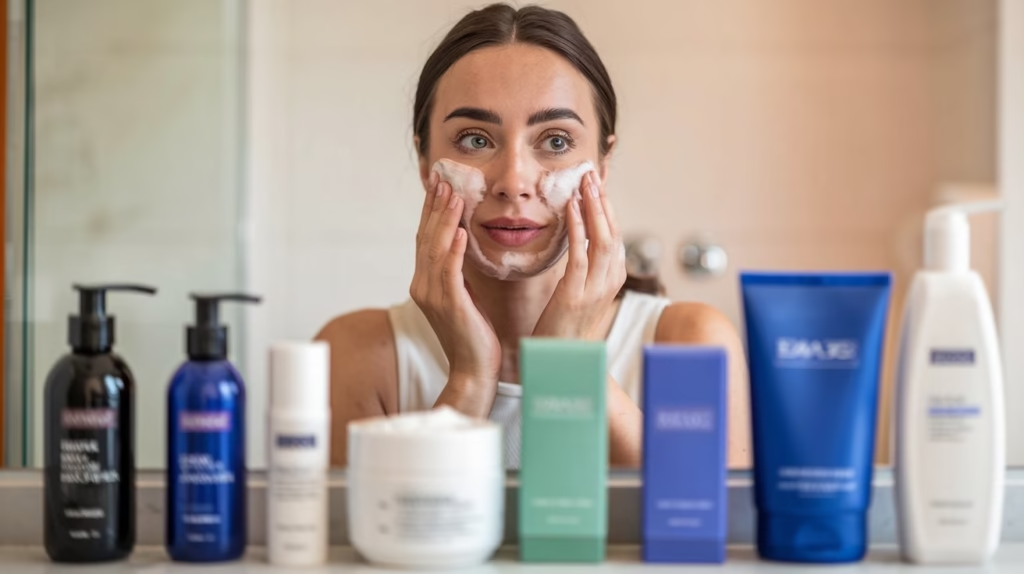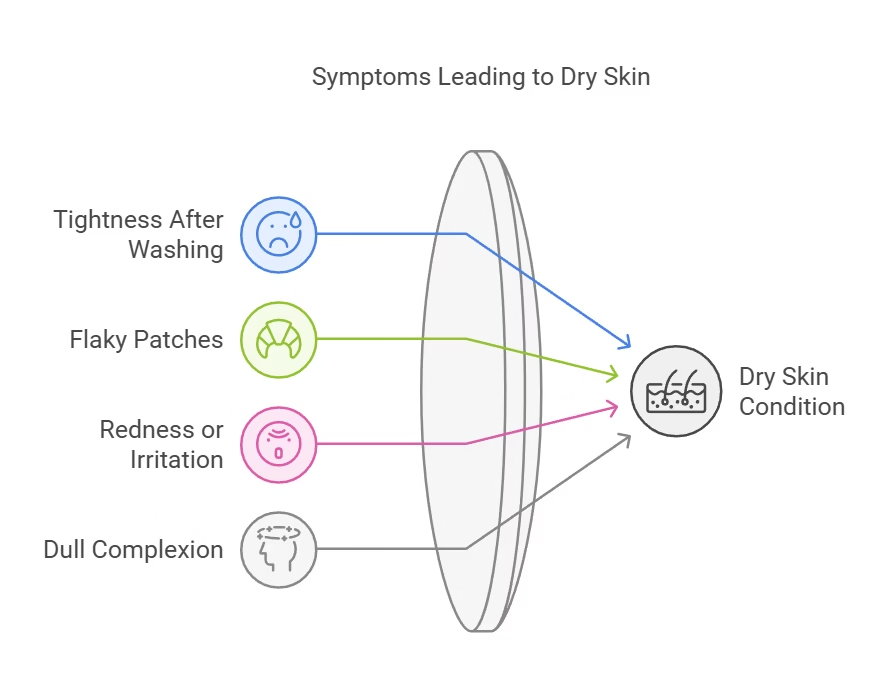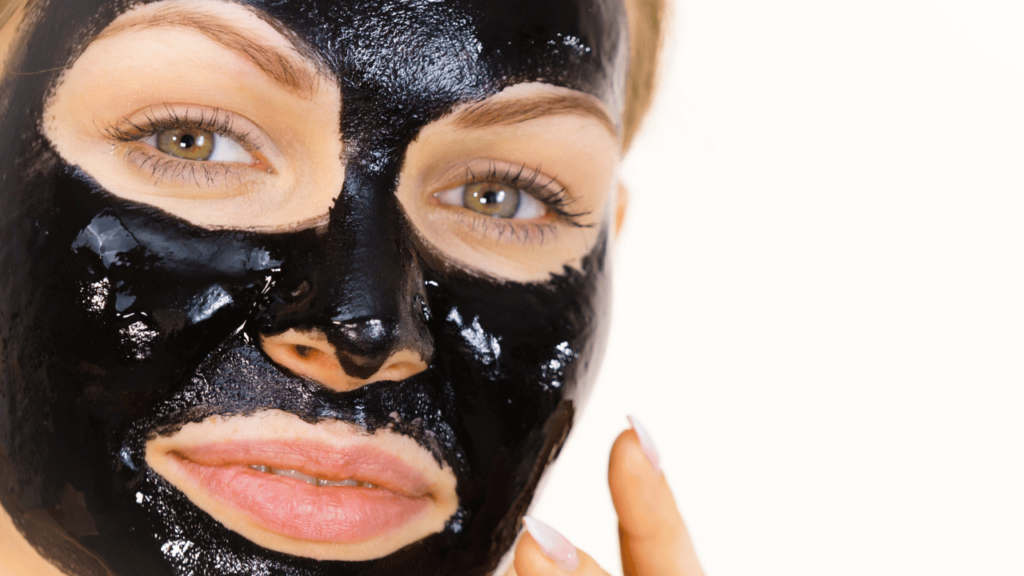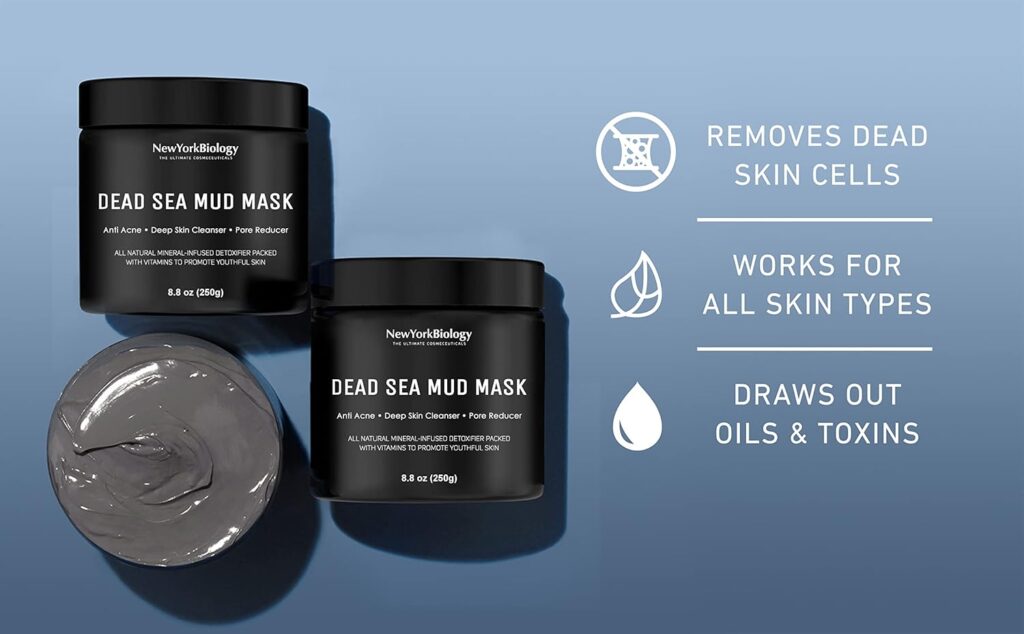Using the correct cleanser is essential to keeping your skin hydrated and healthy if you have dry skin. Any skincare routine starts with cleansing, but it’s possible to pick the wrong product that takes away your skin from the moisture it really needs just because lack of knowledge. For this reason, picking the best cleanser for dry skin is very important.

Dry skin is often characterized by tightness, rough patches, redness, or even flakiness. These symptoms can worsen if you use a cleanser that’s too harsh or doesn’t have the ingredients your skin requires. A gentle, hydrating cleanser can help restore balance and keep your skin soft and smooth.
In this article, we’ll explore how to choose the best face wash for dry skin, what ingredients to look for, and how to build a skincare routine that works with your skin’s unique needs. By the end, you’ll understand how to choose a hydrating cleanser that will leave your skin feeling soft and nourished.
A guide to choosing a cleanser for your skin type
What Causes Dry Skin?
Several factors can contribute to dry skin. Weather is one of the biggest culprits—cold, windy conditions or indoor heating can strip moisture from your skin. Other causes include:
- Genetics: Some people are naturally prone to dry skin.
- Age: As you get older, your skin produces less oil, leading to dryness.
- Skincare Products: Harsh cleansers, soaps, or products with strong chemicals can disrupt the skin’s natural moisture barrier.
- Health Conditions: Conditions like eczema, psoriasis, or thyroid imbalances can lead to dry skin.
Common Symptoms and Concerns of Dry Skin
Dry skin isn’t just about how your skin feels—it shows up in how it looks too. Some common symptoms of dry skin include:
- Tightness or discomfort after washing
- Flaky or scaly patches
- Redness or irritation
- Dull complexion

These symptoms can often worsen with the wrong skincare routine. Harsh cleansers can aggravate dry skin by removing essential oils and causing further irritation. That’s why it’s so important to choose a cleanser that nurtures your skin, rather than stripping it of its natural moisture.
Key Considerations When Choosing a Cleanser
Before you choose a cleanser, it’s crucial to assess your skin type. Dry skin can vary from person to person. Some may experience slight dryness, while others struggle with severe dehydration and flakiness. Knowing whether your skin is mildly dry, extremely dry, or even sensitive can help you select the right product.
When assessing your skin, ask yourself:
- Does your skin feel tight or dry after washing?
- Do you experience irritation or redness easily?
- Is your skin rough or flaky?
If you answered “yes” to any of these, it’s time to choose a hydrating cleanser specifically designed for dry skin. Understanding your skin type will ensure you pick a product that hydrates without causing further irritation.
Ingredients to Look For When choosing a cleanser for dry skin
The ingredients in your cleanser play a huge role in its effectiveness. For dry skin, you want a formula that hydrates and nourishes while gently cleansing. Here are some key ingredients to look for:
- Hyaluronic Acid: Known for its ability to hold moisture, hyaluronic acid attracts water to your skin, leaving it plump and hydrated.
- Glycerin: A humectant that helps draw moisture into the skin, glycerin ensures your skin stays hydrated after cleansing.
- Ceramides: These lipids help repair the skin barrier, preventing moisture loss and protecting your skin from external irritants.
- Shea Butter: A rich, natural moisturizer that soothes and softens dry skin, providing much-needed hydration.
Gentle Surfactants vs. Harsh Chemicals
When selecting a cleanser, it’s also important to pay attention to the surfactants (cleansing agents) used in the formula. For dry skin, avoid cleansers with harsh surfactants like sodium lauryl sulfate, as they can strip the skin’s natural oils. Instead, opt for gentle, non-foaming cleansers that won’t cause dryness or irritation.
Formulation Types
Cleansers come in a variety of formulations, and not all are suitable for dry skin. Here’s a breakdown of what works best:
- Creamy Cleansers: These are ideal for dry skin because they are hydrating and soothing, leaving your skin soft and moisturized.
- Oil-Based Cleansers: Perfect for dry skin, oil cleansers help dissolve dirt and makeup without stripping moisture.
- Hydrating Gel Cleansers: These provide a burst of hydration while gently cleansing, making them a great option for dry skin.
Avoid Foaming Cleansers: While foaming cleansers may feel refreshing, they tend to be too harsh for dry skin. They can strip moisture, leaving your skin feeling parched and uncomfortable.
Ingredients to Avoid When choosing a cleanser for dry skin

Harsh Sulfates and Alcohols
Sulfates (such as sodium lauryl sulfate) are commonly used in many cleansers to create foam. However, they can be very harsh on dry skin. While they are effective at removing dirt and oil, they also strip the skin’s natural moisture barrier, leaving it feeling tight and irritated.
Similarly, alcohols (especially drying alcohols) can have the same effect. They may offer an immediate cooling sensation, but they ultimately contribute to skin dehydration by breaking down the moisture barrier. For dry skin, it’s best to avoid cleansers that contain these ingredients.
Fragrance and Dyes
While fragrances and dyes can make a product smell nice or look appealing, they can irritate dry skin, especially if it’s sensitive. These additives can lead to redness, itching, or allergic reactions, which is the last thing you want when your skin is already feeling dry and uncomfortable.
Look for products that are fragrance-free and free of artificial dyes. Opting for gentle, unscented formulas ensures you won’t risk irritation or sensitivity.
Harsh Exfoliants
Some cleansers contain exfoliating beads or strong chemical exfoliants that may seem like a good way to slough off dead skin cells. However, for dry skin, these can be too aggressive. Over-exfoliating can strip the skin of natural oils, exacerbating dryness and irritation. If your cleanser contains exfoliating agents, make sure they are gentle and suitable for dry skin.
Strong Detergents
Some detergents in cleansers can be too harsh for dry skin. Look for formulas that use mild surfactants, like decyl glucoside or coco-glucoside. These are much gentler on your skin, ensuring a more hydrating cleanse without compromising the skin’s moisture barrier.
Recommended Cleansers for Dry Skin
Best Cleansers for Dry Skin: Top Picks to Hydrate Your Skin
1. CeraVe Hydrating Cleanser
- Key Ingredients: Ceramides, Hyaluronic Acid
- Skin Type(s): Normal to Dry
- Cruelty-Free: No
CeraVe’s Hydrating Cleanser is a popular choice for dry skin, and for good reason. Packed with ceramides and hyaluronic acid, this cleanser helps restore the skin’s protective barrier while delivering intense hydration. Its non-foaming formula gently cleanses without leaving your skin feeling tight or dry. It’s also fragrance-free, making it a safe choice for those with sensitive skin.
2. Avene Milk Cleanser
- Key Ingredients: Glycerin, Thermal Spring Water
- Skin Type(s): Sensitive, Dry
- Cruelty-Free: No
Avene’s Milk Cleanser is perfect for those with sensitive, dry skin. This rich, creamy cleanser uses glycerin to attract moisture to the skin, leaving it hydrated after every wash. It also contains thermal spring water, known for its soothing and anti-inflammatory properties, making it an ideal choice for those with irritated skin. This gentle cleanser won’t disturb your skin’s natural balance, leaving it soft and nourished.
3. Osea Ocean Cleansing Milk (Our Choice)
- Key Ingredients: Undaria Seaweed, Glycerin
- Skin Type(s): Dry, Sensitive
- Cruelty-Free: Yes
Osea’s Ocean Cleansing Milk is a luxurious option for dry skin. This nourishing cleanser combines Undaria seaweed with glycerin, offering deep hydration and helping to restore the skin’s natural glow. It’s formulated to be gentle on sensitive skin while providing a thorough cleanse. Plus, Osea is a cruelty-free brand, making this a great option for those who prioritize ethical skincare.
How to Use Cleansers for Best Results?
Choosing the right cleanser is a crucial step in any skincare routine, but how you use it is just as important, especially for dry skin. To make the most out of your hydrating cleanser, follow these simple yet effective tips for the best results:

1. Use Lukewarm Water
When cleansing dry skin, it’s important to avoid using hot water, as it can strip the skin of its natural oils. Instead, use lukewarm water to gently open the pores and allow your cleanser to work more effectively. Hot water can also cause irritation, so always opt for a temperature that feels comfortable on your skin.
2. Apply Gently with Your Hands
When applying your gentle cleanser for sensitive skin, use your fingertips to massage it onto your face in circular motions. Avoid using a washcloth or scrubbing too hard, as this can irritate and dry out the skin further. Gently massaging your cleanser into your skin helps to break down dirt and impurities without causing friction or damage.
3. Don’t Over-Cleanse
It might be tempting to wash your face multiple times a day, but over-cleansing can actually worsen dry skin. Washing your face twice a day—once in the morning and once at night—is usually sufficient for dry skin. Over-cleansing can strip your skin of its natural oils, leading to more dryness and irritation.
4. Be Sure to Rinse Thoroughly
After massaging the cleanser onto your face, make sure to rinse thoroughly with lukewarm water. Any leftover cleanser can leave a residue that may dry out your skin or cause irritation. Be gentle when patting your face dry with a towel—avoid rubbing, as this can cause unnecessary friction.
5. Follow Up with a Moisturizer
After cleansing, your skin may feel soft and hydrated, but it’s essential to lock in that moisture with a good moisturizer for dry skin. Apply your moisturizer while your skin is still slightly damp to help seal in the hydration. This step is crucial to prevent any moisture from evaporating and to keep your skin feeling soft and nourished throughout the day.
6. Frequency of Cleansing
For dry skin, cleansing twice daily is often sufficient. Over-cleansing can lead to irritation and excessive dryness. If your skin feels particularly dry or tight after cleansing, consider cutting back to just once a day and see how your skin responds.
Skincare Tips for Dry Skin
1. Moisturize After Cleansing
Moisturizing is an absolute must for dry skin. After cleansing, your skin may feel soft, but without the right moisturizer, that moisture can evaporate quickly. Always follow up your cleansing routine with a rich moisturizer that’s designed for dry skin. Look for products that contain ingredients like ceramides, glycerin, and hyaluronic acid, which help lock in hydration and restore your skin’s moisture barrier.
2. Use a Hydrating Toner
A toner can be a great addition to your skincare routine, especially if you struggle with dry patches or uneven skin texture. Look for a hydrating toner that’s alcohol-free to avoid further drying out your skin. Ingredients like rose water, aloe vera, and glycerin are fantastic for replenishing moisture and soothing dry skin. Apply your toner after cleansing and before moisturizing for an added layer of hydration.
3. Apply a Serum for Extra Hydration
If your skin feels excessively dry or tight, you may want to consider incorporating a serum into your routine. Hydrating serums are lightweight and packed with powerful ingredients like hyaluronic acid that help draw moisture into the skin. Apply the serum after your toner but before your moisturizer to give your skin that extra dose of hydration.
4. Avoid Hot Showers and Harsh Weather
While it might feel good to relax in a hot shower, the heat can strip your skin of its natural oils, making dry skin even worse. When you wash your face, opt for lukewarm water. Also, during colder months, the dry air can exacerbate dryness. Consider using a humidifier in your home to keep moisture in the air and prevent your skin from drying out.
5. Protect Your Skin from the Sun
Dry skin is more vulnerable to the sun’s harsh rays, which can further damage the skin and contribute to moisture loss. Make sure to apply a broad-spectrum sunscreen with an SPF of at least 30 every day, even when it’s cloudy. Choose a sunscreen that’s formulated for sensitive skin to avoid irritation.
6. Regular Exfoliation (But Gently)
Exfoliating helps remove dead skin cells and can prevent your skin from looking dull. However, for dry skin, you’ll want to choose a gentle exfoliator that won’t be too harsh. Avoid scrubs with large, abrasive particles and opt for exfoliators with AHAs (alpha hydroxy acids) or gentle enzymes that help slough off dead skin without causing irritation. Limit exfoliation to once or twice a week to avoid over-drying.
Conclusion
Choosing the right cleanser for dry skin is not just about picking a product from a shelf—it’s about understanding your skin’s unique needs and selecting a formula that nurtures and hydrates. In this guide, we’ve covered everything from identifying your dry skin’s characteristics to the key ingredients to look for in a cleanser. By opting for gentle, hydrating cleansers that avoid harsh chemicals, your skin will thank you with improved moisture retention and a more balanced complexion.
Don’t forget to complement your cleanser with a solid skincare routine that includes moisturizing, toning, and protecting your skin from external factors. Remember, hydration is the foundation of healthy skin, and with the right choices, you can give your skin the care it deserves.
So, take your time and choose wisely. The cleanser you pick today could be the key to smoother, more radiant skin tomorrow.
FAQs
1. What are the key ingredients to look for in a cleanser for dry skin?
Look for hydrating ingredients like hyaluronic acid, glycerin, ceramides, and shea butter. These help lock in moisture and strengthen the skin’s barrier. Avoid harsh ingredients like sulfates and alcohol that can strip the skin of its natural oils.
2. How do creamy or oil-based cleansers compare to foaming cleansers for dry skin?
Creamy or oil-based cleansers are ideal for dry skin as they gently cleanse while maintaining hydration. They don’t strip away essential oils. In contrast, foaming cleansers often contain harsh detergents that can dry out the skin, making them less suitable for dry skin types.
3. Are there any specific brands known for making the best cleansers for dry skin?
Yes, some top-rated brands include CeraVe, Avene, Osea, and Neutrogena. These brands offer cleansers with hydrating ingredients that are gentle on dry and sensitive skin.
4. How often should I cleanse my dry skin to maintain hydration?
Cleansing twice a day—once in the morning and once at night—should be sufficient. Over-cleansing can strip the skin of essential oils, so avoid cleansing too frequently.
5. Can using a cleanser with hyaluronic acid help reduce fine lines and wrinkles?
Yes, hyaluronic acid helps draw moisture into the skin, keeping it hydrated and plump. While it won’t directly reduce wrinkles, consistent hydration can minimize the appearance of fine lines and contribute to healthier, more youthful-looking skin.
6. What type of cleanser is best for dry skin?
The best cleansers for dry skin are creamy, oil-based, or hydrating gel cleansers. These formulas provide gentle cleansing without stripping away moisture, keeping your skin hydrated and balanced.
7. Is cleansing good for dry skin?
Cleansing is essential for dry skin, but it’s important to use a mild, hydrating cleanser. Cleansing helps remove dirt and impurities while preventing buildup, but it should be done in moderation with a suitable product that won’t dry out or irritate your skin.
8. Is gel cleanser good for dry skin?
Gel cleansers can be suitable for dry skin, but it depends on the formula. Look for hydrating gel cleansers with ingredients like glycerin or aloe vera. Avoid foaming or harsh gel cleansers that may strip moisture from the skin.








